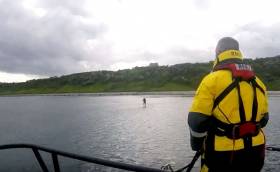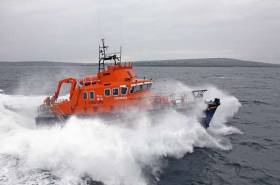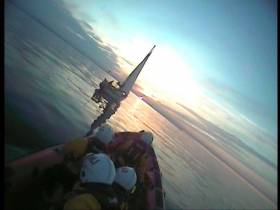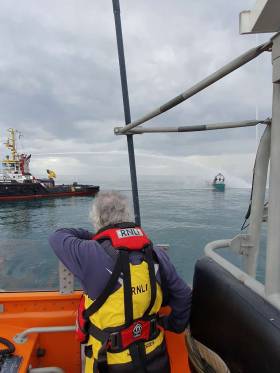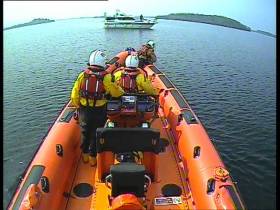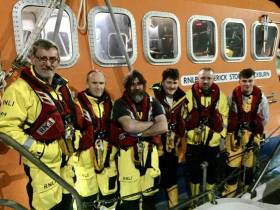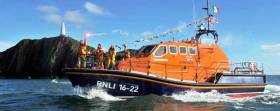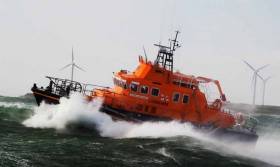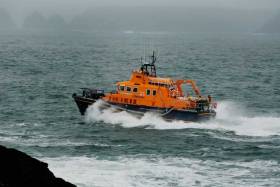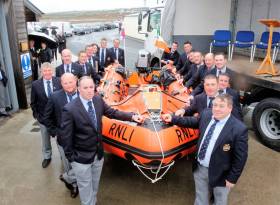Displaying items by tag: Lifeboat
Larne RNLI launched to search for a paddleboarder who was reported overdue from Whitehead yesterday afternoon (Sunday 26 May).
Larne RNLI's all-weather and inshore lifeboats launched at 4.55pm following a request from Belfast Coastguard to assist in the search. Donaghadee RNLI's all-weather lifeboat and Bangor RNLI's inshore lifeboat also launched alongside three Coastguard shore teams, Coastguard helicopter and the PSNI to help locate the paddleboarder who had set off from Whitehead earlier in the afternoon.
Weather conditions at the time were breezy, rough seas and good visibility.
Larne inshore lifeboat conducted a shoreline search including local harbours and bays. The all-weather lifeboat conducted a search further south along the Gobbins coastal path. Following speaking to a local tour guide the crew were directed to a paddle boarder who had been spotted further south of the Gobbins.
The paddleboarder was located safe and well and was happy to make his way back to Whitehead harbour.
Speaking after the call out, Frank Healy, Larne RNLI Coxswain said: ‘Our volunteer crew training kicked in to ensure both our lifeboats were launched quickly to take part in the multi-agency search. Thankfully the casualty was located safe and well.'
‘We would encourage people to enjoy our beautiful coastline but would remind everyone going to sea to always respect the water. Always wear a lifejacket or buoyancy aid, carry a means of communication and let someone know where you are going and when you are expected back and check the weather forecast. Should you get into difficulty or see anyone in distress at sea or on our coastline, call 999 ask for the Coastguard.’
Aran Islands RNLI’s volunteer lifeboat crew spent nine hours at sea last night to help bring a sick fisherman to safety.
The crew were requested to launch their all-weather lifeboat by the Irish Coast Guard at 9.45pm last night (Thursday 23 May) and go to the aid of the sick fisherman on a French vessel approximately 40 miles west of the Aran Islands. The lifeboat under Coxswain Mairtín O'Flaithearta, was requested to assist the crew of the Irish Coast Guard’s helicopter Rescue 115 from Shannon who had been tasked earlier in the night and were already providing casualty care on scene and had attempted to winch the casualty to safety.
Weather conditions were moderate at the time with light westerly winds and a 1.5 to 2m swell.
Once on scene, a lifeboat crew member was transferred on to fishing vessel to assist the helicopter crew. A transfer to the lifeboat was attempted but due to the height of the vessel and the swell this was not possible.
The lifeboat proceeded to escort the vessel north of the Island where there was more shelter and the swell was only 1m. By this time the fisherman was well enough to be winched by the Irish Coast Guard helicopter and airlifted to hospital.
The Aran Islands RNLI all-weather lifeboat returned home at 6.30am this morning.
Speaking following the call out, Mairtín O'Flaithearta Aran Islands RNLI Coxswain said: 'The conditions out there last night were challenging due to the height of the vessel and sea conditions. The volunteer crew members drew on all their training and their joint exercises with the Coast Guard to aid in a successful rescue. We wish the fisherman a speedy recovery.’
Portaferry RNLI rescued a lone sailor last night (Wednesday 22 May) after his 25ft yacht got into difficulty in the Irish Sea.
The volunteer crew were requested to launch their inshore lifeboat at 8.51pm following a request from Belfast Coastguard to go to the aid of an overdue sailing vessel that had sustained engine failure and had one man onboard.
The lifeboat helmed by Paul Mageean and with three crew members onboard launched immediately and made its way to the scene at South Rock close to Cloughey Bay. The Coastguard helicopter Rescue 199 from Prestwick was also tasked.
Weather conditions at the time were good with a Force 2 westerly wind and a calm sea state.
Once on scene, two lifeboat crew members were transferred onto the yacht to assess that the sailor was safe and well before proceeding to set up a tow.
The yacht was then safely towed back to Portavogie Harbour.
Speaking following the call out, Portaferry RNLI Helm Paul Mageean said: ‘We are pleased with the outcome of this call out as it could have been a lot worse for the man onboard as the sailing vessel was close to one of the shipping channels when we arrived on scene. This callout showed good teamwork between ourselves in the RNLI and our colleagues in the Coastguard.
‘As we approach the summer, we would remind anyone planning a trip to sea to always respect the water. Always check your boat and engine ahead of your trip, always let someone ashore know where you are going and when you are due back and always carry a means of communication. Always wear a lifejacket and should you get into difficulty or see someone else in trouble, call 999 or 112 and for the Coastguard.’
Arklow and Wicklow RNLI were involved in the rescue of three fishermen yesterday evening after their 14m trawler caught fire and subsequently sank off the Wicklow coast.
Volunteer lifeboat crew at Arklow and Wicklow RNLI were requested to launch their all-weather lifeboats at 3.46pm following a Mayday relay broadcast. The crew of the boat had used an emergency position-indicating radio beacon (EPIRB) to raise the alarm.
Both lifeboats launched immediately while the Irish Coast Guard helicopter Rescue 117 from Waterford was also tasked and multiple vessels in the area responded.
Weather conditions at the time were good with a Force 2-3 westerly wind.
Once on scene 30 miles east of Arklow, the crew onboard Arklow RNLI’s all-weather lifeboat observed that the three casualties had evacuated on to their life raft and had transferred to a nearby vessel. Having assessed the situation, the lifeboat crew proceeded to transfer two of the casualties to the lifeboat and administer casualty care while a third casualty was airlifted by Rescue 117 and later brought to hospital for further observation.
Wicklow and Arklow RNLI then stood by as a tug boat with firefighting capabilities made efforts to put the fire out but the vessel later sank.
Arklow RNLI transferred the two casualties back to the station where they were made comfortable.
Speaking following the rescue, Arklow RNLI Coxswain Ned Dillon said: ‘Thankfully, all three fishermen were rescued this evening and we would like to wish them all a speedy recovery following what must have been a frightening experience for them. We would like to commend the skipper and his crew for doing the right thing and activating the Epirb when they knew they were in difficulty, that was the right thing to do. We would also like to thank and commend the crew of the vessels that were in the area and responded along with ourselves and our colleagues at Wicklow RNLI and in the Irish Coast Guard. It is always sad to see a fishing vessel sink but we are happy that all three fishermen are safe and recovering from their ordeal this evening.’
At 1.14pm on the Saturday 20 April Carrybridge RNLI’s inshore lifeboat, Douglas Euan & Kay Richards and Rescue Water Craft (RWC) were launched to a vessel with two people which had run aground North West of Knockninny.
Winds were Southerly, Force 0. Visibility was excellent with a part cloudy sky.
The lifeboat and RWC arrived with the casualty vessel and after checking the people on the boat where ok the volunteer crew checked the boat for water ingress and found none. With the owner’s permission, the vessel was refloated and towed into deeper water and again the boat was checked for water leaks as well as the steering and propulsion checked and all was found to be ok.
The vessel was then able to continue on its planned journey.
Whilst the lifeboat and RWC were returning to the station the crew were alerted by another vessel with two people on board which had broken down. The crew assisted the boat by towing it back to a private marina.
Speaking following the call out, Stephen Scott, Lifeboat Operations Manager at Carrybridge RNLI advised all boat users: ‘to enjoy the fantastic weather over the holiday period, but as it is for many the start of the boating season to carry out regular maintenance checks and to plan their voyage using relevant charts. We would also remind all water users to wear lifejackets and to respect the water. If you see someone in trouble on the water or are in difficulties yourself the number to dial is: 999 or 112 and ask for the Coastguard.’’
The Courtmacsherry All-Weather RNLI Lifeboat was called out at 7.40 pm last night (Saturday) to go to the aid of a 40 ft Yacht which sought assistance 34 Miles off Courtmacsherry and due south of the Seven Heads peninsula in West Cork.
Under Coxswain Sean O Farrell and a crew of five, the Lifeboat was quickly away on the Bank Holiday Saturday and immediately made its way at full speed to the yacht.
The yacht had four persons on board and was en route to Spain from Ireland when they lost engine power two days ago.
Yesterday evening, they were losing all battery power as well and sought assistance from The Coastguard.
The Lifeboat reached the causality at 9.30 pm and immediately took the Boat in tow. After a slow tow in good conditions, the Lifeboat and the yacht arrived at the safe surrounds of the CastlePark Marina in Kinsale at 2.45 am this morning. The crew of the yacht were well pleased to be on safe soil early this morning, as they were drifting helplessly over the past few days in calm winds.
The Crew on this long callout were Coxswain Sean O Farrell, Mechanic Tadgh McCarthy and Crewmembers Ken Cashman, Denis Murphy, Evin O Sullivan and Conor Tyndall.
Having been at sea for over eight hours, The Trent Class Lifeboat “Frederick Story Cockburn” returned to its moorings in Courtmacsherry just after 4 am, after refuelling.
RNLI: A Centenary for Baltimore, New Lifeboats for Clogherhead & Wicklow & Crosshaven Needs Volunteers
When Baltimore Lifeboat Station in West Cork was established the First World War was raging in Europe. That was back in 1915 when the original station was built, but due to the War no lifeboat arrived in Baltimore until 1919 …. and there was some feeling about her name…. She had been launched as the ‘Duke of Connacht,’ but because of sentiment in the wake of the Easter Rising of 1916, her name was changed to the ‘Shamrock’ before she arrived in Baltimore.
One of my particular maritime memories is being aboard the Baltimore Lifeboat when it used to be launched down the slipway from inside the old station. There was a steel girder across the roof and, if I remember correctly, it had a warning: “Mind Your Head” which flashed over the top of the lifeboat as it rapidly went down the slipway into the water.
This came to mind when I was given a look through the station’s recorded history, in conjunction with the planned celebration of its centenary this September.
There’s a fine, modern lifeboat station in Baltimore now, with both offshore all-weather and inshore boats. I remember being there the morning of Charlie Haughey’s rescue from the sinking of his yacht, ‘Celtic Mist’ at the Mizen in October of 1985.
"Back in 1979, Baltimore was the first lifeboat to launch to the rescue of sailors in the Fastnet Yacht Race disaster"
Back in 1979, Baltimore was the first lifeboat to launch to the rescue of sailors in the Fastnet Yacht Race disaster. That event got more attention than another unusual service the same year when the West Cork crew assisted in transferring an injured man to Bantry Hospital following a mutiny aboard a Greek container ship!
There will be a lot happening on the lifeboat scene this year, with the last operational Tyne Class all-weather lifeboat on service in Ireland leaving over the next few months from service in Wicklow and new Shannon Class boats going there and Clogherhead.
And in Cork Harbour, Crosshaven lifeboat station is looking for crew for its inshore boat. Like many village communities, they have a large number of crew working outside the village during the day and, therefore, not available for emergencies, which is putting a strain on their ability to respond in working hours. So they are looking for people over 17 who are at home in the village during the day.
Listen to the podcast where Niamh Stephenson of the RNLI describes the changes and when the new Clogherhead boat will be arriving…..
Rosslare Harbour RNLI Lifeboat Rescues Windsurfer Drifting Out to Sea
Rosslare Harbour RNLI rescued a windsurfer who fell off his board and got into difficulty on Sunday afternoon, ending up in the water for an hour and a half.
The volunteer crew was requested to launch their all-weather lifeboat by the Irish Coast Guard at 1.15pm on Sunday (13 January) after a passer-by raised the alarm.
The man had fallen off his board and despite attempting to get back on, he kept getting blown off by the wind and was being swept out to sea.
The lifeboat under Coxswain Art Sheil and with six crew members onboard, launched immediately and made their way to the scene.
Weather conditions at the time were described as blowing a Force 4-5 south to southwesterly wind.
On arrival, the lifeboat crew located the casualty 1.1 nautical miles offshore. The windsurfer was cold and in shock but otherwise safe and well.
He was subsequently transported onto the lifeboat where he was first assessed and then brought back to the comfort of Rosslare Harbour’s lifeboat station.
Speaking following the call out, Dave Maloney, Rosslare Harbour RNLI Lifeboat Operations Manager said: ‘We would like to commend the member of the public who spotted the windsurfer in difficulty and raised the alarm, that was an important factor in this call out as the man was in the water for an hour and a half. Thankfully, despite being cold and shook up, he was otherwise ok.
‘It is important to always respect the water and to be mindful that conditions at sea can change and cause problems. We would encourage people to always carry a means for calling for help such as a personal locator beacon, especially if windsurfing alone - it could be a lifesaver. Always tell someone you are going out and when you will be back. Make sure they know where you are sailing and who to call if you are not back in time.’
Ballyglass RNLI in 11 and a Half Hour Call Out to Rescue Fishermen After Boat Breaks Down
Volunteers from Ballyglass RNLI spent 11 and half hours at sea today to bring three fishermen to safety off the Donegal coast.
The lifeboat crew were requested to launch their all-weather lifeboat at 4 am yesterday morning following a request from the Irish Coast Guard to go to the aid of three fishermen onboard a 10m vessel that had got into difficulty 38 miles from Ballyglass.
The lifeboat under Coxswain James Mangan and with four crew members onboard launched immediately into the darkness and made its way to the scene and into Donegal Bay.
The fishing boat had got into difficulty when it fouled its propeller.
Weather conditions at the time were good and when the lifeboat crew arrived on scene they assessed that all on board were safe and well before working with the fishermen to establish a towline and then begin the slow journey to Killybegs where they arrived at 10.30am.
Following a short break for breakfast, the lifeboat crew then began the return journey back to Ballyglass, arriving at the lifeboat station and preparing the lifeboat for service again at 3.30pm.
Speaking following the call out, Padraic Sheeran, Ballyglass RNLI Lifeboat Operations Manager said: ‘The fishermen did the right thing this morning raising the alarm when they got into trouble and we were delighted to be able to help them return to shore safely.
‘This was an early morning call out for our volunteers who got out of their beds to respond to their pagers and make their way to the scene. Given where the boat had got into difficulty into Donegal Bay, by the time we reached the scene and towed the vessel safely into Killybegs and made the passage back, our crew had spent 11 and a half hours at sea. This is what they are trained for and prepared to do but their efforts today are commendable, and I would like to thank our volunteer team for their willingness, time and dedication.’
Ballyglass RNLI’s New Inshore D Class Lifeboat Named 'Clann Lir'
At a special naming ceremony and service of dedication held yesterday (Saturday 13 October), Ballyglass RNLI officially named its new D class lifeboat, Clann Lir, in the Mayo coastal town.
The honour of naming the lifeboat went to Derek Moran, Secretary General of the Department of Finance, with the help of Sophie Reilly from Belmullet National School, winner of a competition to choose the name of the new lifeboat.
The lifeboat which went on service earlier this year was funded by a donation from the Central Bank of Ireland.
The Central Bank, on behalf of the Department of Finance, issues several commemorative coin products every year to mark different historical events, figures and to promote Irish arts and heritage.
The Central Bank had scheduled the launch of its 2017 Annual Mint Set, which paid tribute to the vital work carried out by the Irish Coast Guard and Irish Lighthouses for March 2017. However, the launch was postponed following the tragic loss of the crew of Rescue 116 on 14 March 2017.
Following the tragedy the Minister for Finance agreed that the proceeds from the sale of the Annual Mint Set 2017 be donated to a nominated charity. The RNLI was selected as the main beneficiary of this donation as its work closely aligns with the work of the Irish Coast Guard and the Commissioners of Irish Lights.
Almost 4,900 Annual Mint sets were sold up to the end of January this year and a donation of just over €74,000 was made to the RNLI. The proceeds have been used to fund the new lifesaving vessel which is stationed at Ballyglass, with the remainder going towards lifeboat kit equipment and crew training.
During the naming ceremony, Eddie Diver, Ballyglass RNLI Fundraising Chairman, accepted the lifeboat on behalf of the charity, from Gerry Quinn, Chief Operations Officer of the Central Bank, before handing her over into the care of Ballyglass Inshore Lifeboat Station.
Having accepted the lifeboat on behalf of the volunteer crew, Lifeboat Operations Manager Padraic Sheeran in his address paid tribute to all involved at the station: ‘I thank Eddie for handing us this new D Class lifeboat, and the Central Bank of Ireland for donating it to us. Thanks to everyone here today and to our great supporters of the station. And last but not least a huge thank you to the volunteer crew and fundraising committee - as Lifeboat Operations Manager it’s a pleasure to work with you all.’
The Clann Lir was blessed in a service of dedication led by Father Kevin Hegarty before the lifeboat was officially named by Derek Moran.
The new inshore lifeboat replaces The Western which launched 58 times while on service in Ballyglass coming to the aid of 20 people. Clann Lir will now serve alongside Ballyglass RNLI’s all-weather lifeboat Bryan and Gordon which has launched 153 times since going on service in Ballyglass, with her crews coming to the aid of 153 people, 14 of whom were lives saved.
The name of the new lifeboat is one close to the heart of those in the Belmullet community and was chosen by Sophie Reilly, a pupil at Belmullet National School.
Pupils in the school were given the task of nominating a suitable name for the lifeboat that had to be Irish with either a nautical or community theme. Three names were shortlisted by the volunteers in Ballyglass RNLI before the station’s volunteers picked a fitting winner, Clann Lir.
Clann Lir or The Children of Lir, is an Irish legend that tells the story of Lir and his four children. Bodb Dearg, king of the Tuatha De Danann and rival of Lir, gave his daughter Aeb to Lir, in order to appease him. Lir and Aeb had four children: one girl, Fionnuala, and three sons: Aed and twins Fiachra and Conn. Aeb died and Bodb Dearg sent another of his daughters, Aoife, to marry Lir.
Aiofe was jealous of the children's love for their father and for this reason she decided to kill them but did not have the courage; instead using her magic she changed the children into swans. They were condemned to wander for 900 years over certain lakes and rivers in Ireland.
The children had to spend 300 years on Lough Derravaragh, 300 years in the Sea of Moyle and their last 300 years as swans at Sruwaddacon Bay near Erris in County Mayo, before flying to Inishglora, an island off the coast of the Belmullet Peninsula.
Here they met a monk who baptised them. Instantly they had back their human shapes but because of their very old age they died immediately. They were buried on the island in the one grave.
The RNLI formally established a lifeboat station in Ballyglass in 1989 and today the volunteers work from two stations that are home to an all-weather lifeboat, Bryan and Gordon, and the new inshore lifeboat.
The D class lifeboat has been the workhouse of the RNLI’s lifesaving service for nearly 50 years. It is inflatable but robust; highly manoeuvrable and capable of operating much closer to shore than all-weather lifeboats. It is specifically suited to surf, shallow water and confined locations, often close to cliffs, among rocks or even in caves.
First introduced to the fleet in 1963, the design of the D class has continued to evolve since its introduction and the latest version was introduced in 2003. As with all D class lifeboats, the Clann Lir has a single 50hp outboard engine and can be righted manually by the crew after a capsize. Onboard equipment includes both fitted and hand-held VHF radios, night-vision equipment, and first aid kit, including oxygen.
The 5m lifeboat is landrover launched and has a 25-knot maximum speed. It can carry up to three lifeboat crew and five survivors.
A crowd of well-wishers turned up to see the lifeboat officially named with a bottle of champagne poured over the side of the boat at the end of the ceremony.
Among the guests on the platform party were Michael Cosgrove, fundraising secretary who welcomed guests and opened proceedings, Gerry Quinn, Chief Operations Officer of the Central Bank of Ireland who handed over the lifeboat, Eddie Diver, Ballyglass Fundraising Chairman who accepted the lifeboat on behalf of the RNLI and handed it over into the care of Ballyglass Lifeboat Station, Padraic Sheeran, Ballyglass RNLI Lifeboat Operations Manager, Derek Moran, Secretary General of the Department of Finance who named the lifeboat, and Sophie Reilly, winner of the competition to pick the name of the lifeboat.


























